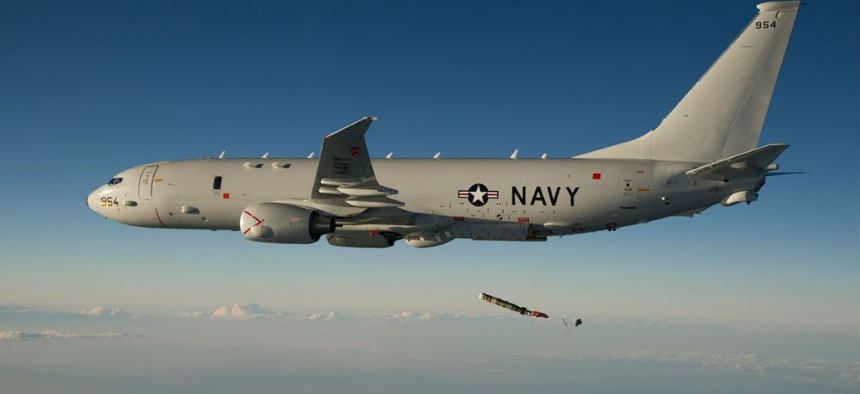Navy improves P-8A surveillance plane, drone integration
The Navy and Boeing are modernizing software systems for the P-8A Poseidon surveillance aircraft to link with manned and unmanned systems.
The Navy is modernizing software for its Boeing P-8A multi-mission maritime surveillance aircraft to improve Anti-Submarine Warfare, Anti-Surface Warfare and operational integration with unmanned systems service officials said.
The P-8A multi-mission maritime aircraft was first engineered for the Navy’s Maritime Patrol and Reconnaissance Force (MPRF) to replace the P-3 Orion aircraft after it had been in use for 50 years.
The P-8A carries out intelligence, reconnaissance, and surveillance (IRS) using the AN/APY-10 Raytheon radar system, which provides detailed imaging of land, marine, and littoral zones, and has the unique ability to detect briefly surfaced submarine periscopes.
According to Naval Air Systems Command (NAVAIR), the aircraft also carries torpedoes and cruise missiles, as well as sonobuoys, which are deposited into the water and use sonar technology to locate submarines.
“The P-8A Poseidon system sustains and improves the armed maritime and littoral intelligence, surveillance and reconnaissance capabilities for United States naval forces in traditional, joint and combined roles to counter changing and emerging threats,” said Lt. j.g. Seth Clarke, a spokesman for the Navy.
Maritime surveillance has been transitioning toward unmanned systems, yet the P-8A operates with a nine-person crew. Navy and industry developers say the P-8A remains in operation because it provides concentrated intelligence that is essential to complete surveillance.
“It is equipped to complement (and may be integrated with) unmanned assets while also providing fleet operators with the added benefit of interfacing with unmanned aircraft systems when performing certain operations and missions,” Lt. Clarke explained.
The P-8A works with the Broad Area Maritime Surveillance—Demonstrator (BAMS-D), NAVAIR’s unmanned aircraft program, which is capable of large-scale surveillance and feeds data to the P-8A systems. The P-8A aircraft can then be used more effectively by being deployed to areas identified as requiring more sophisticated reconnaissance.
Boeing, aircraft’s manufacturer since the original contract was awarded in 2004, expects the work to be completed by December 2019.
The latest contract awarded to Boeing is a $41,329,057 indefinite delivery-indefinite quantity contract is for software maintenance and support, engineering analysis, and prototype development.
It also provides for software modernization and improvements to enhance the operation utility of the P-8A working in collaboration with BAMS-D. The contract is a fixed-price-incentive-fee, meaning that Boeing will receive a fee for fulfilling the contract that will increase or decrease depending on whether work is completed within or above the given budget.





